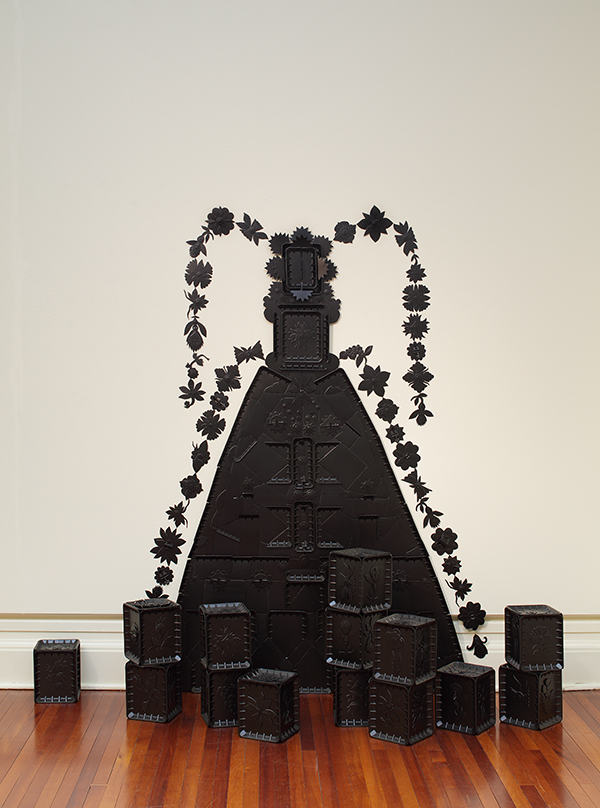Sarjeant Blooming on the Quay
Andrea Gardner ‘Rosette’ 2003, black plastic meat-trays, 2005/15/1. Collection of the Sarjeant Gallery, Te Whare O Rehua, Whanganui. Gift of the artist, 2005.
Sarjeant Blooming on the Quay
Spring is blooming at the Sarjeant Gallery with an exhibition, Bloom: Floral Works from the Collection that celebrates the season. Paintings, ceramics and even jewellery bedeck the gallery walls and floor space, and there are some unusual works that attest to the diversity of our creative response to the natural world.
Adjacent to Edith Collier and Harry Richardson’s portraits of young girls, glowing with the promise of youth against a backdrop of flowers, Andrea Gardner’s black, environmentally acute Rosette (pictured) stands out, both because of its unspring-like colour and the opposites it embodies. The installation resembles a Minoan goddess form, or a fountain of flowers made from recycled Styrofoam meat trays. Unlike real flowers that bloom, wither and die these will never biodegrade. So this strangely beautiful work, created out of trash, both attracts and repels, while stimulating reflection.
The theme of floral motifs allowed the inclusion of many works from the collection that are rarely seen because they don’t usually fit with other exhibition themes. Sections within the exhibition include a range of still life paintings; flowers as pattern; prints; botanical studies and gardens; examples from the arts and crafts movement; flowers used for contemplation and to mark significant life events; ceramics and “the whimsical”. Among the still life section, Flower Study, attributed to 17th century Dutch painter Jan Baptiste, is a collection treasure, “a stunning still life that is unusual in that there is a shadowy landscape in the dark background.”
Curator of the exhibition, Jennifer Taylor Moore says still life paintings often evoke death and the impermanence of life by showing the beauty of a flower in the process of dying as it wilts in a vase. This particular painting tradition began in the 16th century following the Protestant Reformation when Catholic ornamentation and portraiture was removed from churches and homes. “Artists, looking for another source of commissions, began painting flowers and interiors, infusing them with symbolic meaning.”
Opposite the still life section hang avant garde works such as Fiona Pardington’s black and white photograph For the price of lilies (A portrait of Joseph Makea), 1985, in which a young Polynesian man, naked to the waist, holds a bunch of arum lilies in his bandaged hands. It’s an incongruous image of a man holding a bunch of flowers, and the way he is looking at the viewer is quite challenging. He could be a boxer; perhaps he is injured. We don’t know.”
The Rick Rudd ceramic box collection presents small boxes of different forms and techniques decorated with floral motifs. One of the curator’s favourites is the quirky “Princess Box” by Ann Verdcourt of a princess with big hair in a big dress. “Her hands and face are obscured in her hair – she’s quite overwhelmed by it.” On the back an inscription declares, “A princess that everyone knows. In these frocks I look just like a box. Sprinkled with feathers and bows.” The piece references 18th century Rococo dresses with large panniers. Skirts could be as wide as 4.5 meters, obliging women to go sideways through doors.
On the weekend of the 5-6 November the Sarjeant is holding a spring weekend festival in the Gallery. The public is invited to take part in art making and to attend talks and demonstrations by floral artists and gardeners, tours of the exhibition and entertainment.
Helen Frances


